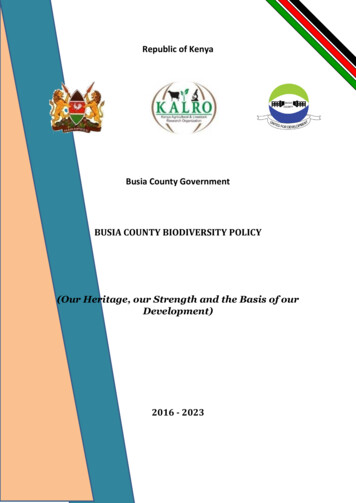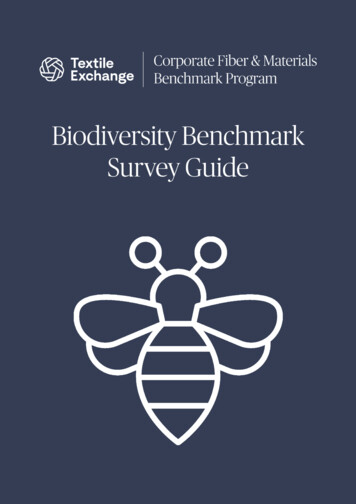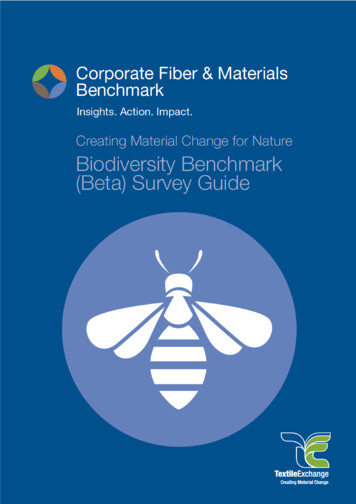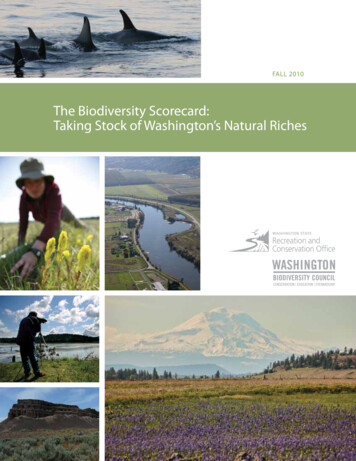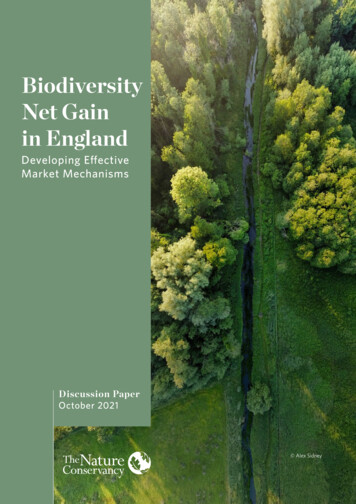
Transcription
Executive Summary IPBiodiversityNet Gainin EnglandDeveloping EffectiveMarket MechanismsDiscussion PaperOctober 2021 Alex Sidney
ForewordLynn Scarlett, Chief External Affairs OfficerThe Nature ConservancyWorldwide, losses of biodiversity continue at an alarming pace, jeopardizingnatural systems and the benefits they provide to communities and economies.Reflecting this trend, in the UK, 15 percent of terrestrial and freshwater speciesface extinction. Changing this trajectory requires new policies and new rules thatreverse this trend. Offsetting biodiversity losses and incentivizing investmentsin nature offer a ‘new deal for nature.” The potential for mobilizing the powerof a nature marketplace is significant, but that power requires clear goals andsmart rules. This report, Biodiversity Net Gain in England, builds on experienceswith biodiversity markets across the globe to help shape the UK’s pathway toprotecting and restoring nature.Peter Simpson, Chief Executive OfficerAnglian Water GroupThe climate and biodiversity crisis is upon us. It is for us to solve nowbecause it will be too late if we leave it to future generations. Our region haslost a lot of its biodiversity over the last century and we must join forces withothers to put it back, for its own sake but also to underpin growth and theregion’s economy. This welcome paper highlights challenges and issues thatneed to be addressed to ensure that Biodiversity Net Gain works for natureand is trusted by practitioners and stakeholders. I believe that, done right,Biodiversity Net Gain can help reverse biodiversity loss. Done right, we canhelp the region’s beleaguered habitats and species and reap benefits for thecommunities we serve. And crucially, restoring biodiversity will help us bothmitigate climate change and adapt to the inevitable impacts we face, such asflooding and drought.Rosie Begg & Glenn Anderson – LandownersWendling Beck Exemplar ProjectThis timely report from TNC highlights the risks and areas needing furthertransparency to ensure BNG policy can deliver landscape change at scale.Both buyers and sellers need more clarity if they are to plan projects properlyand engage with different markets early. From a landowner perspective, itis imperative that clear rules around the stacking and bundling of differentecosystem services are defined as quickly as possible. BNG has been keyto habitat restoration and nature creation around the world and the UK canbegin with strong foundations thanks to the lessons TNC share in this report.Michael Copleston - Head of LandRSPB EnglandIf it’s done well, biodiversity gain should be a step change for habitatcreation and nature recovery in England. The conservation sector hasbeen clear that there are a lot of potential pitfalls in how biodiversity gainis designed and implemented - Government and every other organisationinvolved in biodiversity gain will need to learn everything possible frominternational experience and academic research.
DevelopingBiodiversityEffective MarketNet GainMechanismsin England IIIIIPPTable of ContentsExecutive Summary I1. Introduction 11.1 Paper objectives 41.2 Paper structure 42. BNG policy in England: where we are and where we are going 2.1 Biodiversity in development planning in England: an historical perspective 672.1.1. Adoption of a ‘no net loss’ policy 82.1.2. From no net loss to biodiversity net gain 92.2 Expected changes under the Environment Bill 112.3 Current and anticipated BNG market activity 142.4 Potential risks associated with poor market design 193. How can BNG markets generate maximum gains at least cost? 223.1 Key components for an effective BNG scheme 233.2 Assessing the current status of the BNG scheme in England 264. Selected areas requiring further elaboration for BNG in England 4.1 Measuring biodiversity and driving the right type of investments 30334.1.1. Using ‘habitat’ as a proxy for biodiversity vs. addressing species requirements 354.1.2. Other key considerations for Biodiversity Metric 3.0 374.2 Defining BU delivery mechanisms and enabling a level playing field 414.3 Stacking and bundling: How can projects mobilise diversified funding sources? 434.4 Enabling functioning markets: what can government do? 484.4.1. Ensuring robust and predictable demand for BUs 494.4.2. Stimulating BU supply 504.4.3. Facilitating market transactions 514.4.4. Stimulating investment in BU supply 545. Next steps: checklist for market players 56Annex 1: BU delivery mechanisms in the US 60
PP IVIVBiodiversity Net Gain in EnglandAnnex 2: Potential funding instruments for BNG 65Annex 3: Potential incentive mechanisms 67Annex 4 : Glossary 70Annex 5: References 74Acknowledgements 79FiguresFigure ES-1. England’s progress towards establishing effective BNG markets IIIFigure 2-1. Relevant policy and wider developments influencing BNG in the UK,including influential EU policy 8Figure 2-2. Ongoing BNG market activities in England 14Figure 2-3. BNG Market size in England 18Figure 2-4. Annual BNG funding compared to public and non-profit biodiversityfunding in England in 2018-2019 19Figure 4-1. Overview of main discussion areas covered in this section 32Figure 4-2. What should a good biodiversity metric cover? 34Figure 4-3. Objectives and associated rules for stacking and bundling 45Figure A-1. Offsetting mechanisms in the US wetland and streams mitigation scheme 60Figure A-2. Advantages and disadvantages of offsetting mechanisms prevalent in the US 61Figure A-3. US historical uptake of habitat banks 64
DevelopingBiodiversityEffective MarketNet GainMechanismsin England VPTablesTable 3-1. Key components for an effective BNG scheme 24Table 3-2. UK progress on the BNG components 26Table 4-1. Examples of time to maturity for different habitat types 39Table 4-2. Types of stacking and bundling 44BoxesBox 1-1. Potential benefits of a mandatory BNG scheme 3Box 2-1. The mitigation hierarchy for biodiversity: from avoidance to net gain 9Box 2-2. Post-Brexit environmental reforms in the UK – a rapid overview 11Box 2-3. The biodiversity metric and UKHab classification 12Box 2-4. Warwickshire: from participation in the Defra pilot to broader adoption 15Box 2-5. The Wendling Beck Exemplar Project: an early supplier of BUswithin an emerging market 15Box 2-6. US wetland and stream mitigation scheme – a quick overview 18Box 2-7. The US wetland and stream mitigation program’s evolution: from on-siteto off-site mitigation 20Box 4-1. Stacking and bundling: definitions 44Box 4-2. International lessons associated with stacking and bundling 48Box 4-3. No net loss or net gain market transparency measures in the US and Australia 53Box A-1. Twelve standards of the US wetland and stream’s mandatory offset plan 62
P IBiodiversity Net Gain in EnglandBiodiversity Net Gain in England:Developing Effective Market Mechanisms IP Alex SidneyExecutiveSummaryExecutive Summary
IIPBiodiversity Net Gain in EnglandThe UK is in the process of establishing newpolicies and rules for biodiversity, substitutingfor those that applied under European Unionpolicy and legislation. Following a two-year transitionperiod, the Environment Bill (expected to receiveRoyal Assent in 2021) will make biodiversity net gain(BNG) mandatory for most housing and infrastructuredevelopments, including mining. Developers subject tothis requirement will need to provide a plan to deliverBNG with their applications for consent, based on themitigation hierarchy and a prescribed habitat-basedmetric. For impacts that cannot be avoided, minimisedor offset on site, infrastructure developers will need tocompensate for these impacts off site. They may be ableto achieve this through purchasing biodiversity units(BUs), thereby creating a market referred to as the BNGscheme or BNG market in this paper.This discussion paper has been prepared to supportthe net gain goal for biodiversity on land and infreshwater through approaches that deliver the bestoutcomes at least cost. The paper seeks to supportthe development and implementation of England’s BNGpolicy. It also provides a framework that can help othercountries exploring biodiversity offset markets.Establishing a well-functioning BNG scheme willinvolve significant effort. A well-designed regulatoryframework is essential for the scheme to operateeffectively. To that end, England can leverage knowledgefrom other countries to set up markets that work well fromthe start. In the United States, where biodiversity offsetmarkets are well developed and worth approximatelyUSD 3.9 billion a year, such rules have evolved overseveral decades and are now firmly rooted. England canalso draw upon examples in Australia and continentalEurope.Lessons from international experience, reflectedin this paper, suggest that 20 critical componentsare essential to underpin effective BNG markets (seeTable 3-1 in the main report for more details). Thesecomponents can be grouped into three categories: Alex Sidney
Executive Summary IIIPWhatWhoHowBNG foundations and ground rulesset out the rules that all marketactors must follow for overallpositive outcomes for biodiversityBU delivery mechanisms androles define rules for the use ofeach mechanism and roles andresponsibilities for all stakeholdersDisclosure and schemeadministration provide the basis forensuring that market actors complywith the underlying rules.Some essential building blocks are already in place in England, and others are under development, but a number ofcritical components require further clarity to achieve the best possible outcomes for biodiversity (as shown on figureES-1 and Table 3-2 in the main report).FigureES-1.England’sprogressprogress atBNG foundations and ground rulesAddressedMandated3 Loss/gain methodology2 Policy scopePartially/not fully addressed1 Policy goal4 Mitigation hierarchy5 Strategic spatial plan6 BNG site selectioncriteria8 BNG actions/additionality7 Durability criteria9 Habitat types/equivalence10 Duration of offset11 Performance criteria & standards12 Timing of compensation &credit releaseWhoBU delivery mechanisms and roles13 BU delivery mechanisms14 Clear rolesHowDisclosure and scheme administration15 Net gain plans16 BU delivery plans17 Permitting process and timeline18 Monitoring and long-termreporting20 BNG tracking systemLegend Addressed via metric19 EnforcementAddressed via Environment BillPartially/not fully addressedMandated via secondary legislation
IVPBiodiversity Net Gain in EnglandA metric for calculating biodiversity losses and gainsis in place in England but is not without its limitations.Its application and effectiveness will need to be assessedthrough careful monitoring. Recognising that certainlosses are traded for uncertain gains where a habitat proxyis used, we recommend development of mechanisms toensure the maintenance of existing high-distinctivenesshabitats that are not designated or protected, but whichrequire ongoing maintenance management. The costsof maintaining existing high-distinctiveness habitats arenot always covered in the current system. If the focus ofthe BNG scheme is mostly on creating new habitats, thisintroduces a genuine risk that existing habitats will not beprioritised or maintained.Mechanisms for delivering gains in the form ofBUs need to be clarified, along with transparent rulesfor setting up habitat banks that guarantee paritybetween on-site and off-site compensation. Experiencefrom the US wetland and stream mitigation scheme hasshown that a non-level playing field between on- andoff-site compensation (for example, laxer monitoringand enforcement) can lead to a preference for on-sitecompensation despite poor ecological success. Studieson ecological impact assessments (EcIAs) in Englandhave also identified poor effectiveness of on-siteecological mitigation. Balanced rules for on- and off-siteBNG delivery are expected to increase demand for off-sitehabitat banking, which may generate better biodiversityoutcomes and boost market liquidity.Landowners need clear rules for stacking andbundling. This will make it easier to assess whetherthey can sell multiple environmental services (includingbiodiversity) emanating from land use changes and howto do so. In the short term, a period of market design andlearning through trials will enable the development ofadequate rules for the BNG market.To become established, the market will needadditional support. Measures can feed robust andpredictable demand, stimulate supply and smoothtransactional aspects of the market, such as markettransparency. Demand guarantees provided bygovernment and pre-purchase allowances areinterventions that ensure robust and predictable demandfor BUs. Interventions that stimulate supply of BUs varywidely: greater flexibility in trading between adjacentStudies on ecological impact assessments inEngland have also identified poor ecologicaleffectiveness of on-site mitigation measures.and non-adjacent local planning authorities (LPAs),supporting production of BUs in advance of transactions(‘habitat banking’), measures to de-risk BU supply, andfinancial incentives, such as governmental grants and taxrelief.International good practice is to maintainconservation assets in perpetuity, in accordancewith no net loss or net gain policy. Thirty years couldprove to be insufficient time to achieve lasting gains,particularly for some habitats that take a long time toreach maturity and become fully colonised by thrivingpopulations of associated species. We recommend thatgreater consideration be given to the need to maintainsome high-distinctiveness habitats beyond 30 years, toallow time for them to reach maturity and to ensure thatbenefits are sustained over time.Secondary legislation and guidance accompanyingthe Environment Bill must provide clarity. To deliverpolicy efficiently and ensure clear market rules, itmust include defined governmental roles and sufficientregulatory capacity. Multiple government roles in themarket could result in perverse outcomes and conflicts ofinterest. Government core functions are to regulate BNGfor individual planning developments and to monitorpolicy outcomes over time. Another important aspect isensuring sufficient regulatory capacity. BNG places anadditional burden on authorities already operating beyondcapacity, and many LPAs lack ecological expertise.
Executive SummaryIn its current form, the BNG scheme in England could generate GBP100 to 300 million annually. The market size prediction is based on marketmodelling assuming an average price per BU of GBP 20,000, a loss of up to15,000 BUs per year and a 50 to 100 percent off-site compensation deliveryrate (in line with the US wetlands and streams market, where approximately80 percent of impacts were compensated for offsite in 2017). This would givelandowners acting as BU suppliers access to a predictable funding sourcefor sustainable land use change. However, some funds would go to covertransaction costs. This means that funding for net additions to biodiversity(over and above compensation) would be relatively insignificant, below GBP10 to 30 million per year. Some possible additions to the scheme (such aspermitting stacking of biodiversity and other environmental credits) couldalso have high transactional costs that need to be accounted for. It is criticalthat the costs of setting up the scheme do not outweigh the potential benefitsand additional revenues generated through it.We recommend expanding the reach of a well-designed BNG scheme toleverage additional funding for biodiversity. Potential ways to do this overtime could include:UCrank up the level of ambition: raise the goal for net gains over timefrom 10 percent in 2023 to 30 percent in 2030 (or as soon as themarket is well established);UExtend the BNG requirement to Nationally Significant InfrastructureProjects;UAdd marine habitats to the scope of mandatory net gain;UBoost the visibility and transparency of this market so it attracts morevoluntary contributions;UGive clearer direction on spatial planning for BU delivery—andprioritise off- over on-site mitigation where it gives the bestoutcomes for biodiversity (species as well as habitats) through localnature recovery strategies;UUse BNG to renature previously developed areas in the greybelt (post-industrial land or former mines, unused factories andcommercial areas) not suitable for infrastructure development;UTap the BNG processes for wider UK nature recovery ambitions—forexample, by deploying the biodiversity metric for approaches tohabitat evaluation, management and pricing under environmentalland management schemes (ELMS) Glenn Anderson VP
Glenn AndersonBiodiversity Net GainIntroductionin England1. IntroductionBiodiversity Net Gain in England:Developing Effective Market Mechanisms 1P
2PBiodiversity Net Gain in EnglandBiodiversity continues to decline globally, drivenby unprecedented urban expansion, conversionof land for agriculture, development ofinfrastructure to meet the demands of an increasinglyglobal human population and climate change (Bull etal., 2020; Diaz et al., 2020; Garibaldi et al., 2020; IPBES,2019; Maron et al., 2018; UN Population Division, 2019).In the UK, despite starting from a relatively impoverishedbaseline, the National Biodiversity Network’s ‘State ofNature’ report for 2019 (www.nbn.org.uk) reported a 13percent decline across UK taxa since 1970, with 15 percentof terrestrial and freshwater species considered to befacing extinction (Haxyhow et al., 2019). For mammals, thefigure is as high as 25 percent (Matthews and Harrower,2020).Global and national targets to halt biodiversitydecline have not been met. New global agreements callfor much greater emphasis on restoration of biodiversity,ecosystems and the services they provide, to compensatefor losses. The 15th Conference of the Parties (CoP) tothe UN Convention on Biological Diversity (CBD) is in theprocess of negotiating a ‘new deal for nature’ to be adoptedin 2022. This will include the universal adoption of themitigation hierarchy, which mandates avoiding impactsas the first and most important step, before minimisingimpacts and offsetting residual impacts. In addition, thedeal is likely to set ambitious but ‘plausible’ global goals ofno net loss by 2030, and 10 percent to 15 percent net gainby 2050 (CBD, 2020). Reaching the CBD’s global targetswill require much greater emphasis on avoiding newimpacts to biodiversity and restoring already convertedand degraded ecosystems while offsetting residual losses.Biodiversity offsets have been identified as a marketbased mechanism that could generate significantprivate sector funding flows for biodiversity. A recentreport by the Paulson Institute, The Nature Conservancyand the Cornell Atkinson Center for Sustainability (2020),amongst others, reviewed the biodiversity-fundingpotential of mandatory no net loss or net gain policies.The report concluded that about 95 percent of impacts tonatural areas are currently not offset and estimated thatcompensation of approximately USD 162 to 168 billion peryear would be needed to address these impacts to achieveno net loss across all countries. This equates to GBP 116 to121 billion per year, approximately 25 percent to 35 percentof the estimated global biodiversity financing gap (DeutzTo date:42CountriesRegulatory no net lossor net gain requirementsin place66CountriesEstablished provisionsto enable voluntary nonet loss or net gain28CountriesUndertaking initialexplorations of policyoptions59CountriesNo policies in placeSource: zu Ermgassen et al., 2019et al., 2020). To date, 42 countries have regulatory no netloss or net gain requirements in place, 66 countries haveestablished provisions to enable voluntary no net loss ornet gain, 28 are undertaking initial explorations of policyoptions, and 59 countries have no such policies in place (zuErmgassen et al., 2019)).The UK is establishing new policies and rulesets forbiodiversity on land and for freshwater, substitutingfor those that applied under European Union policyand legislation, which include provisions for mandatorynet gains. The Environment Bill (expected to receiveRoyal Assent in 2021) will make BNG mandatory formost types of development from 2023. As a solid startingpoint, England has adopted a biodiversity metric (Pankset al., 2021), which gives clear, nationwide rules on howto assess losses and gains in biodiversity for purposes ofdemonstrating BNG. The national approach sets Englandapart from many other biodiversity offset schemes (suchas in the US, Australia, Germany or France), which usemany different regional metrics, resulting in a lack ofconsistency (ICF and IEEP, 2014) and making it challengingto track outcomes at a national level.Potential benefits from a mandatory BNG schemevary across stakeholders (see Box 1.1). To ensure thatthe BNG scheme reaches its full potential in England andto avoid risks which can result from a poorly designedscheme, careful policy and regulatory design is key.
Introduction 3PBox 1-1. Potential benefits of a mandatory BNG schemeFor society as a whole, mandatory BNGincentivises protection of biodiversity byinternalising the costs of biodiversity loss.Without a mandatory BNG requirement,developers are not liable for the costs of habitatdestruction resulting from housing and land usedevelopment. They have a limited incentive toreduce their negative impacts. Mandatory BNGholds developers accountable for their actions, inline with the polluter pays principle. Because theymust pay to offset any residual impacts to ensureoverall net gain, developers have an incentive tominimise their impacts on biodiversity. In wellfunctioning markets, prices of highly distinctivehabitats are prohibitively high and a powerfuldisincentive.For stakeholders looking to transform land use,BNG will allow mobilising private sector fundingfor these activities. As a point of reference, in2016 alone, USD 4.8 billion (GBP 3.4 billion)in transactions were generated through BNGor no net loss mitigation banks and financialcompensation funds worldwide (Bennet et al.,2017). Approximately USD 3.9 billion (GBP 2.8billion) was generated in the U.S. alone, mostlythrough the wetland and streams mitigationscheme (see Box 2.6). Substantial funding flowsto landowners significantly increase the financialviability of sustainable land management. Habitatcreation, restoration and conservation become afinancially attractive land use alternative, able tocompete with more conventional income sourcessuch as agriculture.For developers, a well-designed BNG schemewould lead to efficient and cost-effectivepermitting processes. Studies on establishednet gain or no net loss schemes internationallyhighlight how well-functioning biodiversitymarkets with numerous third-party BU supplierscan generate cost- and time-saving benefits fordevelopers. In New South Wales, Australia, habitatbanking resulted in the halving of developers’time-to-permit and cost savings of AUD 35 million(GBP 20 million) across 20 projects.For people and communities near on-site andoff-site offsets, BNG schemes can generatemultiple co-benefits. The value of being in naturefor mental health is widely recognized (Bratman etal., 2019). Reversing the destruction of biodiversityand increasing its abundance through net gainpolicy will directly benefit psychological wellbeing. Further, economic co-benefits associatedwith tourism, increased property prices andemployment are likely. Regarding the latter, studiesfrom the US suggest that every USD 1 million (GBP0.7 million) spent on offsets delivers from seven to40 jobs, mostly in rural areas (Duke and ten Kate,2014).For local authorities, BNG may offer incomeopportunities. Public land can be used for thesupply of biodiversity units (albeit risks of crowdingout private BU suppliers would need to be carefullyconsidered). For example, local authorities inWarwickshire and Greater Manchester arealready pursuing BNG as an opportunity to fundenhancements to their local parks and greenspaces while generating additional income.The mandatory BNG rule could enableestablishment of well-functioning markets,spurring demand for voluntary biodiversityoffsets. Such schemes are quite rare at present,particularly when compared to the rapid growthin carbon offsets supported by clear rules orvoluntary agreements such as the WoodlandCarbon Code (WCC). A well-established BNGscheme could result in more companies mitigatingand offsetting their biodiversity impacts to become‘biodiversity neutral’. This could include policies tooffset their historical impacts and be applied toreversing biodiversity loss associated with pastdevelopments and land degradation, rather thanbeing limited to new developments.Source: Authors
4PBiodiversity Net Gain in England1.1 Paper objectivesThis discussion paper has been prepared by a group ofactors looking to support the net gain goal for biodiversityon land and for freshwater through approaches thatdeliver the best outcomes at least cost. No net loss ornet gain policies do not always achieve their ambitions( zu Ermgassen et al., 2019). This paper is intended tosupport implementation of England’s BNG policy duringthe upcoming two-year transition period, inform its futuredevelopment and provide the basis for informing othercountries looking to establish such markets.The paper is intended for:The Nature Conservancy, with support of eCountabilityand eftec and input from many others, has led thepreparation of this discussion paper, drawing on directexperiences with biodiversity offsets in a range ofcountries, including the UK, the United States, Australia,Germany, France, Colombia and Mongolia. We also buildon experience from direct support to the Wendling BeckExemplar Project, a BNG project which has participatedin Natural England’s national credit pilot scheme (seeBox 2.5). We conducted numerous interviews with UK,European and US stakeholders involved in biodiversity nonet loss and net gain markets to draw lessons from theirexperiences.UPolicymakers and executive public bodies (atnational and local level);UDevelopers affected by the upcoming BNGpolicy;UStakeholders interested to act as biodiversityunit (BU) suppliers (including landowners orenvironmental service companies)UOther parties (such as consultants or lawyers)who want to support the development of thepolicy and the market, by providing technicalassistance or acting as intermediaries.UThe wider international environmentalcommunity with an interest in betterunderstanding BNG schemes, supporting theestablishment of BNG in the UK, or disseminatinglessons from the English experience in othercountries.1.2 Paper structureThe paper furthers this discussion in the following sections:Section 2Section 2 provides historical and contextualbackground on the evolution of the UK’s BNG policyto date, including upcoming changes with the adoptionof the Environment Bill, current and anticipated marketactivity, as well as potential risks associated with a poorlydesigned regulatory framework. It will be of particularrelevance to readers who are unfamiliar with the BNGscheme in England and with recent and anticipated marketdevelopments.Section 3Section 3 outlines key components for effective BNGmarkets, drawing on international experience with moremature markets before assessing current progress in theEnglish market against these components and areas forimprovement. This section provides an overall roadmapfor setting up a regulatory framework that will provideclarity and transparency to key market players. It will beof particular relevance to policymakers and implementingagencies looking to design markets.
Introduction 5PSection 4Section 4 discusses in more detail selected areas for the establishment of functioning BNG markets in England:UUMeasuring biodiversity and driving the right typeof investments. This subsection examines howBiodiversity Metric 3.0 (Panks et al., 2021) willprovide the basis for estimating biodiversity lossesand gains in the form of BUs, the ‘currency’ for theBNG scheme. We argue that rigorous monitoring ofits application will be needed to provide the basisfor possible further refinement.UStacking and bundling. Rules on how BNG relateswith other environmental credit and fundingschemes also are not clear. This creates challengesfor BU suppliers hoping to forecast the revenuepotential of sustainable land use interventions.Clear objectives and principles are needed to guidethe definition of rules and guidelines in this area.UEnabling efficient markets through governmentsupport. Supply-side, demand-side, exchangeand financing measures will be needed to lowertransaction costs and boost participation in BNGmarkets, particularly in the early period whenmarkets need to be established.Defining BU delivery mechanisms and enablinga level playing field. BU delivery mechanismsenvisaged in the BNG scheme are not clear. Theseneed to be clearly defined to ensure a level playingfield.Section 5Section 5 summarises key recommendations in a checklist for the stakeholders involved in developing the UK’sBNG policy and market. These range from national policymakers to landowners interested in generating biodiversityunits on their own land.In addition:UAnnex 1 provides an overview of BU deliverymechanisms that are in place in the US wetlandand stream mitigation scheme and identifies howthey have evolved over time;Annex 2 sets out potential funding mechanismsthat could help support the development of BUmarkets;UAnnex 3 sets out other potential incentiveschemes;UAnnex 4 contains a glossary of key terms used inthis paper;UAnnex 5 contains the list of references used forthis paper. Andrew NealU
Biodiversity Net Gain in England2. BNG policy inEngland: wherewe are and wherewe are goingBiodiversity Net Gain in England:Developing Effective Market Mechanisms Glenn Anderson P
12 Timing of compensation & credit release 13 BU delivery mechanisms 14 Clear roles 15 Net gain plans 16 BU delivery plans 17 Permitting process and timeline 18 Monitoring and long-term reporting 20 BNG tracking system 19 Enforcement Legend Addressed via metric Addressed via Environment Bill Mandated via secondary legislation






